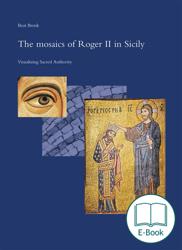The ideas for this book emerged in direct eye contact with the mosaics on the scaffolds of the Cappella Palatina and the Martorana in Palermo and the Cathedral of Cefalù. With their mosaic programs, the three buildings embody unprecedented new creations of the Norman court. The carpet-like lining of the interiors with mosaics and images corresponds to a royal rhetoric, to be understood as unsurpassable and unrepeatable conceptual art. Greek and Italian mosaicists were responsible for the decoration of the huge wall surfaces, which were executed between about 1135 and 1143/1148.
This book on the Sicilian Norman mosaics has an unusual inception story. The ideas expressed in it were generated not primarily through library readings but rather through the direct observation of the mosaics themselves from the scaffolds in the Cappella Palatina and the Martorana in Palermo and the Cefalù Cathedral, as well as those in churches in the Greek East (Daphni, Nea Moni on Chios, St. Michael in Kiev, etc.). The aim, indeed, was to analyse all the mosaics from the greatest possible proximity. At the same time, digital photography, which has developed rapidly in the last twenty years, has been a crucial auxiliary. Seeing at close range has raised new questions that have placed the mosaic as an artistic technique in a broader context. For the first time, it has been possible to present a chemical analysis of tesserae (by Andreas Kronz ) from the Cappella Palatina. New observations on the artistic design and the craft production process of the mosaics, the organisation of the mosaic workshops and the economic conditions of the mosaic are up for debate. The present study is entirely focused on defining the artistic originality of Norman mosaics in comparison to Byzantine programmes and working methods. The common art-historical practice of seeking "influences and models" has been laid aside.
The Martorana, the Cappella Palatina and Cefalù Cathedral are new and unprecedented creations of the Norman court, executed by master builders, sculptors and mosaicists a small proportion of whom were locally sourced, while many others originated from other parts of the Mediterranean region. Greek mosaicists, together with mosaicists probably brought to Sicily from Venice, Rome and elsewhere, formed part of a single workshop that utilized a common approach, common techniques and designs, and was responsible for the decoration of the vast wall surfaces at the three sites, executed between about 1135 and 1143/1148. The three Norman structures, all dating to the reign of Roger II, are virtually awash with mosaics and paintings, a sign of royal rhetoric that should be understood not as a continuation of local traditions but as a form of unsurpassable and unrepeatable conceptual art. King Roger's aim was to surpass all his predecessors with the power of his imperious rhetoric.
All three programmes culminate in a powerful presentation of the celestial hierarchy ruled by the Pantocrator and seconded by archangels, prophets, apostles, saints and Church Fathers, and are characterized by a syncretic union of the Eastern and Western churches together with elements from Fatimid culture. Only the royal palace chapel has been additionally furnished with a programme of New and Old Testament scenes to which Herbert Kessler devotes a profound analysis.
Beat Brenk, born in 1935, received his doctorate in 1960 from the University of Basel, where he was full professor of Early Christian and Medieval Art History from 1977-2002. In 2002, at the age of 67, he was appointed "per chiara fama" to the chair of Christian archaeology at the "Sapienza" of the University of Rome, where he retired in 2010. Invitations to guest professorships took him to the universities of Jerusalem, Hamburg, Utrecht, Johns Hopkins University of Baltimore, Stanford, Williamstown, Scuola Normale Superiore di Pisa and Rome. The author published over 100 essays and 15 books on early Christian and medieval art between 300 and 1200.
Diese Schriftenreihe widmet sich speziell den Forschungen zur Christlichen Archäologie und Kunstgeschichte in spätantiker und frühchristlicher Zeit. Sie umfasst die gesamte Epoche der Spätantike bis zum frühen Mittelalter, im Bereich des byzantinischen Reiches auch darüber hinaus.
Die Reihe ist überkonfessionell und ohne Bindung an bestehende Institutionen, arbeitet jedoch mit der „Arbeitsgemeinschaft Christliche Archäologie zur Erforschung spätantiker, frühmittelalterlicher und byzantinischer Kultur“ zusammen. Sie konzentriert sich vor allem auf die Kunstdenkmäler und versteht sich daher nicht als Konkurrenz, sondern als Ergänzung zu schon bestehenden Reihen, die in der Regel nicht nur die materielle Hinterlassenschaft der alten Kirche, sondern stets auch literarische, theologische und philologische Themen behandeln.
Einer klareren Zuordnung und einer größeren Bandbreite der verschiedenen Disziplinen wegen wurden zwei Unterreihen eingerichtet:
Die Reihe A „Grundlagen und Monumente“ setzt sich schwerpunktmäßig mit einzelnen Denkmälern bzw. Denkmalgruppen im Sinne einer korpusartigen Erfassung der Denkmäler auseinander.
In der Reihe B „Studien und Perspektiven“ werden einerseits Vorträge der Tagungen der „Arbeitsgemeinschaft Christliche Archäologie“ publiziert, andererseits bietet sie ein Forum für Untersuchungen zu den verschiedensten Fragen aus dem Gebiet der spätantiken/byzantinischen Archäologie und Kunstgeschichte.


 Sample
Sample